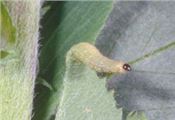Don’t Let This Weevil Eat Your Alfalfa Profits
DR. RIC BESSIN
LEXINGTON, KY.
The earliest field crop pest of the year is often the alfalfa weevil. While adults do some leaf notching, larvae (Figure 1) attack buds and developing leaves, reducing yield and quality of alfalfa. Last year, high numbers were observed in several Western and Central Kentucky counties. With the relatively mild winter, producers are cautioned to scout for young larvae this spring before alfalfa weevil has a chance to inflict serious losses to the first cutting.
Effect of Winter Weather on Insect Survival
Winter weather conditions play a key role in terms of the numbers of weevil larvae we are likely to see and when they show up. Fields with weevils last year are likely to have weevils again this year. Weevils spend winter in alfalfa fields as adults, which lay eggs in dead stems when temperatures are above 48°F. Temperatures below -7°F can kill these winter laid eggs, but Kentucky has not had temperatures to reduce egg survival. There have been several periods of above 48°F, so there have been several egg-laying events this winter.
Scouting for Alfalfa Weevil
The Ag Weather Center has a temperature driven degree-day model used to identify times to begin monitoring for alfalfa weevil activity in fields. Degree days based on a threshold above 48°F are summed from Jan 1; when the total reaches 190DD, it is time to begin scouting fields. Based on winter weather, this can range from late February to Mid-April, depending on the year and location. Surviving winter-laid eggs begin hatching at 190DD, before hatching of spring-laid eggs. Once begun, scouting should be done weekly through the first cutting and its regrowth.
For Alfalfa weevil, use the stem sampling method to scout fields. While walking in a “U” or “Z” pattern through a field, collect 30 alfalfa stems. Carefully cup the top of each stem in one hand and break it from the crown with your other hand; place stems bud-end downward in a plastic bucket. Be sure your samples are at least 20 feet from the edge of a field so that they are representative of the entire interior of a field. Rap groups of 4 or 5 stems at a time against the inside of the bucket to dislodge the larvae. Count the number of larvae. Measure the length of 10 random alfalfa stems. Use the economic threshold tables in ENTFACT 127 or ENT-17 to determine the need to spray the field for alfalfa weevil. If the field is close to harvest, cutting can be an alternative to spraying, but producers need to watch for damage to the regrowth; there are similar scouting tables for regrowth after the first cutting. ∆
DR. RIC BESSIN: Extension Entomologist, University of Kentucky

Figure 1. Alfalfa weevil larva is legless and green with a white stripe down its back and a black head capsule.
Photo: Ric Bessin, UK
